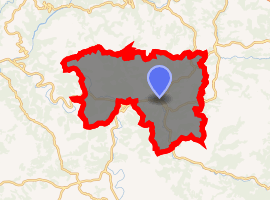Saint-Affrique
Saint-Affrique (French: [sɛ̃t‿afʁik]; Occitan: Sant Africa) is a commune in the Aveyron department in Southern France.
Saint-Affrique | |
|---|---|
The bridge and church in Saint-Affrique | |
 Coat of arms | |
Location of Saint-Affrique 
| |
 Saint-Affrique  Saint-Affrique | |
| Coordinates: 43°57′33″N 2°53′14″E | |
| Country | France |
| Region | Occitanie |
| Department | Aveyron |
| Arrondissement | Millau |
| Canton | Saint-Affrique |
| Government | |
| • Mayor (2001–2008) | Alain Fauconnier (PS) |
| Area 1 | 110.96 km2 (42.84 sq mi) |
| Population (2017-01-01)[1] | 8,089 |
| • Density | 73/km2 (190/sq mi) |
| Time zone | UTC+01:00 (CET) |
| • Summer (DST) | UTC+02:00 (CEST) |
| INSEE/Postal code | 12208 /12400 |
| Elevation | 279–720 m (915–2,362 ft) (avg. 330 m or 1,080 ft) |
| 1 French Land Register data, which excludes lakes, ponds, glaciers > 1 km2 (0.386 sq mi or 247 acres) and river estuaries. | |
History
Saint-Affrique grew in the 6th century around the tomb of St. Africain, bishop of Comminges. In the 12th century a fortress was built on the neighboring rock of Caylus. The possession of Saint-Affrique was vigorously contested during the French Wars of Religion. It was eventually occupied by the Huguenots until 1629, when it was seized and dismantled by a royal army.
Geography
The Sorgues, a tributary of the Dourdou de Camarès, flows through the commune and crosses the town. The Dourdou de Camarès flows northwestward through the western part of the commune and forms part of its northwestern border.
Population
| Year | Pop. | ±% |
|---|---|---|
| 1793 | 4,527 | — |
| 1800 | 5,590 | +23.5% |
| 1806 | 5,348 | −4.3% |
| 1821 | 6,008 | +12.3% |
| 1831 | 6,336 | +5.5% |
| 1836 | 6,421 | +1.3% |
| 1841 | 6,208 | −3.3% |
| 1846 | 6,760 | +8.9% |
| 1851 | 6,618 | −2.1% |
| 1856 | 6,760 | +2.1% |
| 1861 | 6,807 | +0.7% |
| 1866 | 7,046 | +3.5% |
| 1872 | 7,214 | +2.4% |
| 1876 | 7,622 | +5.7% |
| 1881 | 7,598 | −0.3% |
| 1886 | 7,177 | −5.5% |
| 1891 | 7,223 | +0.6% |
| 1896 | 7,026 | −2.7% |
| 1901 | 6,699 | −4.7% |
| 1906 | 6,571 | −1.9% |
| 1911 | 6,495 | −1.2% |
| 1921 | 6,211 | −4.4% |
| 1926 | 6,181 | −0.5% |
| 1931 | 6,592 | +6.6% |
| 1936 | 6,881 | +4.4% |
| 1946 | 7,455 | +8.3% |
| 1954 | 7,236 | −2.9% |
| 1962 | 7,142 | −1.3% |
| 1968 | 7,674 | +7.4% |
| 1975 | 8,223 | +7.2% |
| 1982 | 8,475 | +3.1% |
| 1990 | 7,798 | −8.0% |
| 1999 | 7,507 | −3.7% |
| 2008 | 8,112 | +8.1% |
Sights
An old bridge over the Sorgue and some megaliths in the neighborhood, especially, the dolmen of Tiergues, are of antiquarian interest.
Personalities
Saint-Affrique was the birthplace of:
- Pierre Frédéric Sarrus (1798–1861), mathematician
- Lucien Galtier (1812–1866), priest who built the first Catholic Church in Minnesota, USA
- Pierre-Auguste Sarrus (1813–1876), musician and inventor
- Noël Édouard, vicomte de Curières de Castelnau (1851-1944) General
- Émile Borel (1871–1956), mathematician and politician
- Stéphane Diagana (born 1969), athlete
- Richard Sainct (born 1970), motorcycle racer
International relations
- The town is twinned with Driffield, in the East Riding of Yorkshire, England.
Saint-Affrique prize
The Grand Prix of Saint-Affrique has been awarded to noted Parisian painters since the second part of the 20th century. It consists of a month-long stay of at the hotel of famous chef François Decucq during which the painters could visit and paint one of the most beautiful county of France. Some prize winners: Daniel du Janerand, Maurice Boitel.
See also
References
- INSEE

- "Populations légales 2017". INSEE. Retrieved 6 January 2020.
External links
| Wikimedia Commons has media related to Saint-Affrique. |
- Town council website (in French)
- Unofficial website about Saint-Affrique (in French)